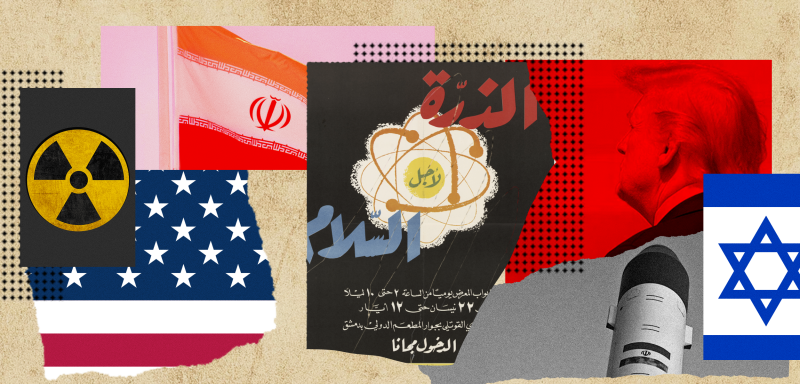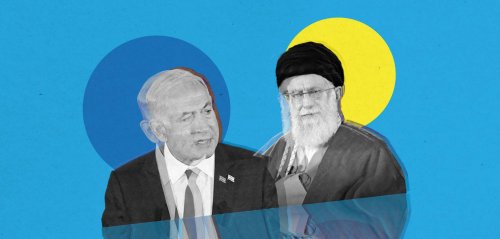In the early hours of June 13th, the world woke to the news that Israel had launched an attack against Iran, thrusting the region into yet another round of escalating violence. This time, however, it was the very scenario the world has feared for decades, all the more so since October 7th, 2023. Despite (or perhaps because of) years of speculation over how an Israeli-Iranian confrontation might unfold, many had been lulled into a false sense of improbability. After all, the stakes are enormous: both nations sit at the cutting edge of military technology, both are economic powerhouses, both command intricate networks of alliances, and both stand to lose immensely from an outright conflict. And yet, here we are today, teetering on the brink of nuclear war, with the specter of total global conflict looming larger than ever.
In this emerging global landscape, a terrifying truth is taking shape: for nations facing the threat of aggression, nuclear armament increasingly appears to be the only reliable shield against destruction. The era of disarmament ideals is giving way to a new global arms race, driven by the grim recognition that raw power, not rules, is now the ultimate guarantor of national security.
This is yet another chapter in the unraveling of the so-called rules-based international order, where principles of sovereignty, non-aggression, and diplomatic resolution are no longer even paid lip service in the face of expansionist violence and great-power opportunism.
The collapse of ethical norms, the erosion of the rule of law, and the sheer unpredictability of events over the past two years make it impossible to foresee the outcome, or even the general trajectory, of the Israel-Iran war.
In this emerging global landscape, a terrifying truth is taking shape: for nations facing the threat of aggression, nuclear armament increasingly appears to be the only reliable shield against destruction. The era of disarmament ideals is giving way to a new global arms race, driven by the grim recognition that raw power, not rules, is now the ultimate guarantor of national security. One thing is certain: the precedents set by this conflict are pushing the world toward greater lawlessness and a renewed embrace of nuclear militarism.
The Decline of the rules-based order
What we call the “rules-based order” is an international system that emerged after the Second World War. It was built on the fragile promise that the horrors of war, imperial conquest, and genocide could be forestalled by a shared commitment to sovereignty, non-aggression, and the peaceful resolution of conflicts.
At least that’s what the brochure said.
In reality, it was a power-sharing arrangement between the victors of the war, designed to regulate their competing interests without once again resorting to open violence. For a time, this system worked for those powers, albeit at the expense of much of the rest of the world. The structure began to falter almost immediately after the Cold War ended. The collapse of the Soviet Union in 1991 disrupted the balance of power that had underpinned the order. The “rules” had only been observed because the two global superpowers maintained a balance through the guarantees of mutually assured destruction. As the threat of nuclear holocaust receded, so too did the major powers’ willingness to abide by these rules.
One of the earliest and clearest signs of this unraveling came in 1999, when NATO bombed Yugoslavia during the Kosovo War without securing a mandate from the UN Security Council. This set a precedent for a series of military interventions outside the legal framework of international law, most notably the 2003 invasion and occupation of Iraq and the subsequent wars waged under the banner of the US-led War on Terror, which has killed an estimated 4.5 million people.
By the eve of October 7th, 2023, the so-called rules-based order had been so thoroughly undermined that the term had become almost a punchline. Yet few anticipated that Israel’s doing away with the proverbial fig leaf would bring back the darkest horrors of the twentieth century, horrors many assumed would remain confined to the pages of history books. The latest war on Gaza, which many experts have agreed constitutes genocide, has shattered that illusion.
In its execution of genocide, Israel has managed to violate virtually every major international convention and rule of war. The list of violations is too long to recount in full here, but a few examples illustrate the breadth and scale of these crimes: the systematic destruction of housing units, universities, schools, clinics, and hospitals; the targeting of water and sanitation infrastructure; collective punishment through blockade, starvation, and forced displacement; the use of sexual violence; arbitrary detention; soldiers disguising themselves as medical personnel to arrest patients; the deliberate targeting of children and aid workers; the establishment of aid distribution points to target starved civilians seeking food. The scope and brazenness of these violations lay bare the collapse of the postwar international system and have set the tone for future conflicts, including the current Israel-Iran war.
Regional collapse and the road to escalation
Following this watershed moment, long-standing regional rivalries and national contradictions – which had seemed to settle into fragile, if contentious, status quos – imploded into full-fledged violence with unpredictable outcomes.
The mounting tensions between Hezbollah and Israel, simmering since the 2006 war, culminated in a brutal new war that ended with Hezbollah’s defeat, its ongoing disarmament, and the occupation of parts of southern Lebanon. In Syria, the uneasy peace that had prevailed since 2018 collapsed after reconciliation negotiations stalled, leading to the fall of the Assad regime, the rise to power of a proscribed jihadi terrorist leader, and the Israeli occupation of large swaths of southern Syria. These brutal new realities have radically reshaped the political map of the region.
By the eve of October 7th, 2023, the so-called rules-based order had been so thoroughly undermined that the term had become almost a punchline. Yet few anticipated that Israel’s doing away with the proverbial fig leaf would bring back the darkest horrors of the twentieth century, horrors many assumed would remain confined to the pages of history books.
Suddenly, Israel found itself having eliminated two of its staunchest adversaries, stripping away one of Iran’s most valuable layers of regional protection. Many observers assumed this would force Iran to quietly retreat from the region, willingly contained by a new nuclear agreement it might strike with US President Donald Trump, the self-styled dealmaker.
But the Israeli government had other plans. Like a gambler who has already wagered too much and believes that doubling down is the only path forward, Israel now saw an opportunity to push for regime change in Iran before having to confront the mounting domestic divisions within Israeli society or face international reckoning for the war crimes it has been committing since 2023.
The collapse of deterrence: Why nuclearization now seems inevitable
Unsurprisingly, the attack on Iran required barely any justification. The collective psyche has been so brutalized since 2023 that one state attacking another no longer shocks the global public as much as the daily images of children bleeding to death.
Israeli Prime Minister Benjamin Netanyahu has been claiming since 1992 that Iran was on the verge of developing a nuclear bomb. This relentless drumbeat manufactured consent for a war Israel had long been preparing for. The image of Colin Powell brandishing a vial sample of Iraq’s (yet to be found) weapons of mass destruction program at the UN Security Council in 2003, and the devastating wars that followed, seemed to do little to instill skepticism about such familiar pretexts.
It mattered little that Iran’s Supreme Leader, Ayatollah Khamenei, issued a fatwa in 2003 explicitly banning the development of nuclear weapons. Nor did it matter that Iran had remained in full compliance with International Atomic Energy Agency (IAEA) inspections until 2021, despite the U.S. reneging on its commitments under the Joint Comprehensive Plan of Action (JCPOA), and ultimately scrapping the deal under President Trump’s first term in 2018. More troubling still, Iran’s status as a signatory to the Treaty on the Non-Proliferation of Nuclear Weapons (NPT) was perversely cited by the U.S and Israel as a rationale for attacking it.
Like a gambler who has already wagered too much and believes that doubling down is the only path forward, Israel now saw an opportunity to push for regime change in Iran before having to confront the mounting domestic divisions within Israeli society or face international reckoning for the war crimes it has been committing since 2023.
The NPT, a Cold War-era treaty, is one of the key instruments that has so far prevented the unchecked proliferation of nuclear weapons. Only nine countries currently possess nuclear arms, and three of them – India, Pakistan, and Israel – remain outside the treaty framework. Weaponizing the NPT against a compliant signatory, especially by a non-signatory state like Israel, threatens to erode the treaty’s credibility altogether. It sends a chilling message to other nations: remaining bound by the NPT may now expose them to aggression rather than protect them from it, making withdrawal from the treaty a rational choice for those seeking to avoid a similar fate.
Until Israel’s attack, Iran’s long-standing posture had been one of strategic ambiguity: maintaining its position just short of nuclear capability. The mere possibility that Iran could develop a bomb served as a powerful deterrent, forcing adversaries to think twice before launching direct attacks for fear of triggering Iran’s nuclear breakout.
For 22 years, this strategy worked and might have served as a model for other nations seeking security without overt nuclearization. But Israel’s aggression has shattered this approach. Now, only an actual nuclear arsenal can provide true deterrence; standing on the nuclear threshold no longer offers protection, but rather paints a target on a nation’s back.
In a further escalation, on June 22nd, the US carried out air strikes on three key Iranian nuclear facilities, Fordow, Isfahan, and Natanz, in violation of international law and of US domestic laws governing the declaration of war. The full extent of the damage remains unclear, with Iranian officials stating that enriched uranium stockpiles and centrifuges had already been relocated from the targeted sites. While an Iranian response is expected, this attack may leave Tehran with little choice but to reconsider its previous posture of restraint.
Weaponizing the NPT against a compliant signatory, especially by a non-signatory state like Israel, threatens to erode the treaty’s credibility altogether. It sends a chilling message to other nations: remaining bound by the NPT may now expose them to aggression rather than protect them from it, making withdrawal from the treaty a rational choice for those seeking to avoid a similar fate.
The Middle East is already riddled with cautionary tales of regimes that sought nuclear capabilities for deterrence, only to suffer devastating consequences when they failed to follow through. Saddam Hussein’s Iraq and Bashar al-Assad’s Syria both developed secret nuclear programs, only to see their reactors bombed by Israel in 1981 (Operation Opera) and 2007 (Operation Orchard), respectively; a policy Israel has openly embraced as the “Begin Doctrine.” Libya’s Muammar Gaddafi abandoned his nuclear program in 2003, hoping for rapprochement with the West in the aftermath of the Iraq invasion, only to face regime change and violent collapse in 2011.
Though the correlation may not be perfectly direct, the pattern is clear: regimes that abandoned or failed to develop nuclear deterrence have been dismantled, while nuclear-armed North Korea remains intact despite decades of isolation and sanctions. Iranian officials and other state leaders are acutely aware of this contrast. The path forward is now all too obvious: for states seeking to pursue developmental policies and avoid destruction, the pursuit of nuclear weapons has become not just an option, but a strategic imperative, and one that must be pursued with haste.
Nuclear powers have already grasped this reality and are rapidly strengthening their arsenals. The deployment of new nuclear weapons has outpaced their dismantlement for the first time since the Cold War, according to the Stockholm International Peace Research Institute’s 2025 annual report. The report warns that the world is entering a new nuclear arms race, one in which states are not only expanding their stockpiles but also modernising them and loosening the protocols that govern their potential use.
Regime Change, Lawlessness, and a Shifting Global Order
By Israeli officials’ own admission, the goal of the attack on Iran is regime change. This is made plain by the nature of Israel’s chosen targets, “symbols of the regime”, and by the very name of the operation: Operation Rising Lion, a reference to the lion emblem on Iran’s pre-revolutionary flag under the Shah.
Israel’s flagrant disregard for international law has also given Iran more room to retaliate in kind, with little concern for provoking Israel’s Western allies. When Israel struck the South Pars gas field in southern Iran, Iran responded by bombing Haifa’s Bazan Oil Refinery. When Israel attacked Iran’s state television headquarters, Iran retaliated by targeting Israel’s Channel 14. When Israeli attacks damage hospitals in Iran, Iran damages the Soroka hospital in Israel. When Israel issues displacement orders, Iran issues them back. These tit-for-tat attacks, all violations of the Geneva Conventions, are precisely the outcome that many UN experts had warned about: that Israel’s conduct in Gaza would erode the legal norms protecting civilians, unleashing a dangerous new era of unrestrained warfare.
The path forward is now all too obvious: for states seeking to pursue developmental policies and avoid destruction, the pursuit of nuclear weapons has become not just an option, but a strategic imperative, and one that must be pursued with haste.
A clash between Israel and Iran may well have been inevitable, but its timing is no coincidence. It follows Israel’s victory over Hezbollah and the fall of the Assad regime in Syria, but it is also driven by deeper shifts in the global political economy. The United States, under the Trump administration, had begun its much-touted “pivot” toward China, the only real threat to US global hegemony. This strategic pivot entails not just a military realignment, with greater emphasis on the Asia-Pacific, but also a restructuring of the global economy aimed at transforming the US into a surplus nation.
As Washington intends to scale back its military presence in the Middle East after more than half a century of intervention, regional powers are scrambling to assert dominance over the political and economic upheavals already beginning to unfold before they crystallize into a new status quo.
Every generation believes it stands at the threshold of a new era. We have the misfortune of being correct. As Antonio Gramsci grimly observed of transitional periods: “Now is the time of monsters.”
Raseef22 is a not for profit entity. Our focus is on quality journalism. Every contribution to the NasRaseef membership goes directly towards journalism production. We stand independent, not accepting corporate sponsorships, sponsored content or political funding.
Support our mission to keep Raseef22 available to all readers by clicking here!
Interested in writing with us? Check our pitch process here!





